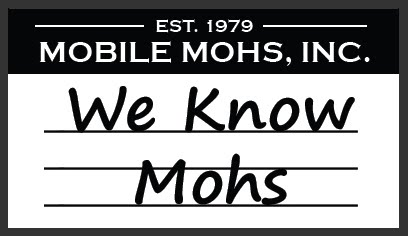 Fatty tissue is, without question, the arch nemesis of the Mohs tech. There you are, cutting beautiful
sections of non-fatty tissue when that spot of fat hits the blade and
BOOM!
Fatty tissue is, without question, the arch nemesis of the Mohs tech. There you are, cutting beautiful
sections of non-fatty tissue when that spot of fat hits the blade and
BOOM! It melts away, leaving a gaping hole in your section and a smudge of yellow mush on your blade.
The problem is simple: Fat does not freeze well. It takes a great deal more time and LN2/Freeze-It to reach the optimal cutting temperature.
Unfortunately, the temp at which fat hardens is often too cold for
obtaining good sections of the non-fatty tissues that may also be present in
the same sample. If this is the case, you can use your A slide to get several cuts with
full epidermis and then work on the fat for the B slide.
Step 1
- A sharp blade and a clean stage.
If your blade is getting dull, this is the perfect time to put in a new one. The knife stage should also be free of any frost, OCT, streaks of tissue, and clumps of melted fat. Use a piece of dry gauze to wipe residue up and away from the blade.
Step 2 - The fat must be EXTRA COLD.
Once the tissue is lined up to the blade and you've cut through the safety layer, spray the yellowish unfrozen fat with short bursts of LN2 or Freeze-It until it turns white. The picture on top shows fat that's a little on the warm side. (Not the best example, since I'd already frozen it and made slides for the doctor by this point) On the bottom, the frozen fat appears more white. The tissue may require several rounds of spraying with the LN2 before it's finally ready to cut, so patience is a must. It's better to take an extra minute with this step than to attempt to cut too soon and waste tissue.
 |
| Freeze artifact with sub-epidermal splitting |
CAUTION: Excessive freezing of the block may cause freeze artifacts such as sub-epidermal splitting or the appearance of "bubbles" due to the expansion of water in the tissue or blood. As mentioned above, you can always make the A slide with sections of non-fatty tissue at the regular cutting temperature and the B slide with fatty sections at the colder temperature.
Step 3 - Cut THICK and FAST.
Once the fat is frozen white (and STAYS white for a few seconds) discard the first one or two wafers. Double ratchet so that your sections are ~6-8µm thick and then slowly cut through the OCT until you've cut into the edge of the specimen. Make sure that the tissue won't roll up, then grab the edge under your brush and coordinate the speed of your right hand with the guiding motion of the brush in your left. Do not press the brush and tissue against the stage or it will stick and you won't be able to cut anything until you clean it. If you manage to crank the wheel in a clean, swift jerk, you'll be able to get reasonable sections of some fairly fatty tissues.
 |
| Some rolling on the bottom edge. Oops. |














.JPG)


+contrast+up,+small+size.jpg)

